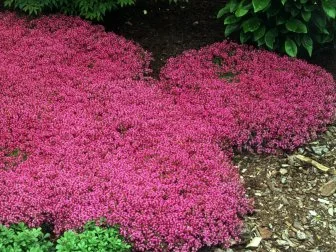How to Plant and Grow Creeping Thyme
Creeping thyme makes a fragrant and functional groundcover.

Shutterstock/Flower_Garden
When creeping thyme is grown in the right spot, it's a low-maintenance and carefree plant.
This diminutive herb may appear to be dainty and delicate, but in the right spot, this low-growing group of related species are actually tough-as-nails and tolerant of bright sun, poor soils and dry conditions. Choose one of these robust groundcovers for deliciously fragrant foliage and eye-catching blooms that are irresistible to pollinators.
Botanical Name: Thymus spp.
Common Name: Creeping thyme
Bloom Time: Summer
Light Needs: Full sun to light shade
Hardiness Zones: Depends on species; many hardy to Zone 6
Height: 2 to 4 inches, depending on the variety or species
Growth Rate: Medium
Creeping thyme hugs the ground, usually growing only a few inches tall. This small-statured groundcover spreads relatively quickly to fill any space between neighboring plants and pavement with fragrant foliage. This flowering thyme's late spring or summer blooms can add a seasonal pop of color, and variegated varieties are cloaked in colorful foliage year-round. While creeping thyme may tolerate being stepped on, they definitely shouldn't be overlooked as a useful and beautiful member of the garden.
Like their close relative common thyme (T. vulgaris), the various species in the creeping thyme group are herbs with both culinary and medicinal value, with antiseptic, expectorant and calming properties. While most gardeners will be familiar with common thyme, this species isn't usually included in the group of ground-hugging creeping thyme. Common thyme may send branches between 6 and 15 inches above the ground, which are much more susceptible to damage when used as a groundcover — especially around pathways. If you have your heart set on common thyme in a creeping setting, you can prune regularly to maintain a more compact habit.

Derek Johnson Visuals
Creeping thyme can be planted between stones in a pathway due to its ability to withstand light foot traffic.
There are a few low-growing species that may be called "creeping thyme," but the most common selections in cultivation are creeping wild thyme (T. serpyllum), Azores thyme (T. caespititius), lemon thyme (T. x citriodorus), caraway thyme (T. herba-barona) and woolly thyme (T. praecox subsp. britannicus).
Creeping wild thyme (T. serpyllum, formerly T. praecox), also called "mother of thyme," is native to the temperate regions of Eurasia, from Eastern Europe to Siberia. This species is hardy in USDA Hardiness Zones 4 to 8. This especially low-growing species hugs the ground, reaching "heights" of about 3 inches and can spread up to a foot. While the straight species usually has mauve flowers, cultivated varieties may bloom in white, pink, red or purple. This species and its varieties are widely available from many garden centers.
Azores thyme (T. caespititius) has adapted to the harsh, oceanic environment of the Iberian Peninsula, Azores and Madeira. Hardy in Zones 6 to 9, this species grows about 4 inches tall and up to a foot wide. Azores thyme forms a low mound with small clusters of somewhat hairy, pine-scented foliage that is clothed in a profusion of bright pink blossoms in early summer.
Lemon thyme (T. x citriodorus) is native to France and Spain, and is hardy from Zones 5 to 8. Depending on the variety grown, this species can get as tall as 6 inches and spread a foot and a half in width. It may have green or variegated leaves, depending on the variety, but all selections give off a burst of fresh, citrus scent when bruised or brushed against. Pale lavender blooms appear at the height of summer. Foliage contains citrol, which makes this a great choice for flavoring vegetables, fish or poultry.
Caraway thyme (T. herba-barona) is native to the Mediterranean island of Corsica. It is hardy in Zones 4 to 8. This diminutive species usually grows about 3 inches tall with a spread of up to a foot. Bright rose-pink summer blooms rest on top of deep green leaves that smell strongly of caraway. Foliage contains the chemical carvone, which is also found in caraway and dill. It's a delicious flavoring for breads, herbed vinegars and sauerkraut.
Woolly thyme (T. praecox subsp. britannicus) is often listed as its own distinct species (T. pseudolanuginosus) or as another subspecies (T. praecox subsp. arcticus), depending on the source. Woolly thyme is native to Iceland, Scandinavia, the British Isles and parts of France and Spain and is hardy in Zones 5 to 8. The ground-hugging, 3-inch-tall stems hold hairy, gray
foliage and will carry pale, pink summer blooms.
How to Use in Your Landscape
When creeping thyme is grown in the right spot, it's a low-maintenance and carefree plant. If you've struggled to grow thyme or other Mediterranean herbs, pause before planting to make sure the site is properly prepared for creeping thyme.
Like many other herbs that are native to the dry and warm Mediterranean region, like rosemary, lavender, oregano and sage, creeping thyme demands well-drained soils. In fact, moist, rich garden soils can lead to weak growth during the season and root rot over cold, wet winters. Creeping thyme prefers the kind of lean, gritty, slightly alkaline soils that are usually common around house foundations or patios.
Gardeners in the South who struggle with sticky, poorly drained clays should amend their clay soil with compost or manure to improve soil drainage. If possible, it's best to spread a layer of sandy loam on top of the amended clay to plant in, although some types of creeping thyme may grow just fine in heavily amended clay.
Creeping thyme will thrive in a sunbaked site, although it can tolerate light shade or partial shade (depending on the type grown). Sunny, south-facing sites are best, and cool, north-facing orientations should be avoided. If you're not sure about the level of exposure in your garden, set aside a day to take some measurements. Pop outside every two or three hours to snap a quick photo of the site. Spots that have at least six hours of sunshine are best for creeping thyme.
Creeping Thyme Groundcover
Creeping thyme does well as a groundcover between taller plants, at the front of the border or rambling between paving stones. A creeping thyme lawn can make a great waterwise alternative to turf in low-traffic areas that have poor soil. These ground-hugging species also make fantastic additions to whimsical fairy gardens and "garden scale" miniature train landscapes. Creeping thyme does well in container gardens, so long as there is consistent soil moisture.
13 Low-Growing Perennial Groundcovers 14 Photos
Need help covering bald spots in your yard or keeping down weeds? These hardy, easy-to-maintain groundcovers — including creeping thyme —may be the answer to your landscaping woes.
How to Grow Creeping Thyme
While creeping thyme can be grown from seed or cuttings, it is usually started from nursery-grown potted plants. Planting creeping thyme from a container is as simple as digging a hole the same depth as the container, gently removing the plant from the pot, placing the root ball into the hole, filling soil around the roots, then giving the plant a good drink of water.
Creeping thyme is easy to divide and spread throughout the yard. Use a sharp spade to separate a section of the plant that has both leaves and roots, then plant somewhere else in your own garden or share with friends and neighbors. It's best to divide creeping thyme during the fall or winter (depending on where you are), when the plant will be less susceptible to transplant stress.
Creeping Thyme Care
Watering
Many gardeners accidentally kill thyme by over-watering. Even if thyme survives frequent watering, it usually doesn't grow very well. If planted in the fall or early spring, creeping thyme may only need to be watered well at planting and as needed (if it starts to droop) during the growing season. Creeping thyme that is planted during the summer may need to be watered well two or three times a week during the first season. For most areas of the country, thyme
doesn't need to be watered after the first year.
Mulching
If you use organic mulch like woodchips or shredded leaves, take care not to bury creeping thyme. Gently sweep any material away from the plant after mulching. Gardeners in especially wet or humid areas may need to take extra care to prevent moisture from rotting their creeping thyme. Lightly mulch around the base of the plant with horticultural grit or pea gravel to create a barrier between the foliage and wet soil.
Pruning
Most types of creeping thyme shouldn't need to be cut back, but if you notice large grey sections or a doughnut-shaped plant that is dead in the center and green on the inside, it may be time to prune your thyme. To rejuvenate, use clean, sharp hand pruners to trim thyme down to about 2 inches in height. Remove any dead, gray leaves and stems at this time.
While thyme can tolerate light pruning for culinary use throughout the year, heavy structural pruning should be done at the beginning of the warm season while plants are actively growing. Wait until late spring after any danger of frost has passed, to minimize the risk of cold damage. Try to avoid pruning after mid-summer, as the fresh, new growth can be more susceptible to cold damage in the fall. When in doubt about timing, prune as soon as the plant is done flowering.
Popular Creeping Thyme Varieties
For Showy Flowers
- T. serpyllum 'Albiflorus' — when in bloom, this white creeping thyme produces drifts of snowy white flowers.
- T. serpyllum 'Annie Hall' — soft pink blooms grown in plants that are reportedly more tolerant of foot traffic.
- T. serpyllum 'Coccineus' — often called "red creeping thyme," this selection bears red-pink blooms on dark green foliage.
- T. serpyllum 'Elfin' — an extremely popular variety for its gray-green foliage and diminutive habit; flowers are lavender-pink.
- T. serpyllum 'Minus' — lavender-pink blooms with dainty, blue-green foliage.
- T. serpyllum 'Pink Chintz' — attractive salmon-pink flowers held above olive-gray foliage
How to Grow and Enjoy Red Creeping Thyme
Discover the easygoing versatility of red creeping thyme plants, and learn how to grow and enjoy them abundantly in your garden or landscape.
For Dazzling Foliage
- T. x citriodorus 'Doone Valley' — variegated white and green foliage shines in the garden during the growing season, with wine red stems in winter; may be incorrectly labelled as C. alba 'Elegantissima' or C. elegantissima.
- T. x citriodorus 'Silver Queen' — olive green leaves with a white margink may have a silver cast.
- T. serpyllum 'Aureus' — a showy, golden leaf variety; site in full sun for best color, otherwise the foliage may fade to green.















































